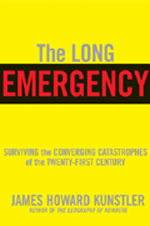Imagine this scenario. On a typical working day, one of your co-workers, who happens to occupy the cubicle next to you comes in with what appears to be a runny nose and a cough. Although he tries to go about his business, his persistent coughing and annoying nose-blowing start to become a distraction. You peer over the partition and tell your colleague he should take the rest of the day off and go home to rest. "I'll be okay" he tells you, and stubbornly carries on. Another case of the typical modern office hero, who feels that the unless he remains at his desk, the entire operation of the company could come tumbling down. Sure, this could be nothing more than a benign little ailment, but it also could be something that could affect the operations of the entire company. In fact this very scenario played itself out not so long ago.
Two years ago, I was nearing the end of a work assignment with a firm that had me providing the research that drove a fair bit of business development. In the middle of March, I took my daughter to pre-school only to find out that a sign had been posted on the door of the school warning parents that a mysterious ailment had been discovered at the local hospital. Doctors had no clue where this virus had come from, or how to treat it. The only thing they did know was that it was highly contagious and potentially fatal. Given the daycare arrangements for our daughter, my wife and I agreed that the best course of action would be to keep her at home for a week (like most of the other parents) – I would alter my schedule to be with her. As far as my own work was concerned, we were trying to land a fairly big chunk of business, and given that my contribution to the effort would be to provide the research – I decided to give teleworking a try.
Although I told the team leader of the situation and the solution I had proposed (actually, we ended up winning the business), he took it upon himself to casually mention prior to a meeting with another client that he was having ‘behavioral problems’ with one of his team members. At the time, he had no idea how serious North America’s first outbreak of SARS would become. Unfortunately, his views, like so many other managers were grounded in a firm belief that in order for workers to be effective, they need to be within a manager’s line of sight. In fact, this happens to be the dominant factor that limits the spread of teleworking.
Pandemics and infectious disease tend to be topics managers don’t want to acknowledge because if they do, the measures required to protect workers against their outbreaks would require a substantial reconfiguration of a contemporary workplace and ultimately, control over workers. In past posts, we have discussed the implications of pandemics, but a
news item we stumbled upon reminds us again of how serious the outbreak of bird flu in the Far East could be.
Vietnam says five members of a family who operate a chicken farm have tested positive for bird flu. A health official says initial tests show the H5N1 virus is present in samples taken from a man, his wife and their three daughters. The doctors say they believe the family contracted the illness through direct contact with the birds. However they can't rule out the possibility of human-to-human transmission.
If bird flu isn’t scary enough, there is fear of a
new “superbug” that may signal the start of a deadly epidemic.
MRSA, or methicillin-resistant Staphlycoccus aureus, normally thrives in hospitals, making sick people sicker – and doctors know which antibiotic will beat it. But a more powerful strain of MRSA has been spreading among healthy people who have never been in hospital, first in the United States and now in Canada. Standard antibiotics don't seem to slow its ravages at all.
As organizations hear about more and more instances of the outbreak of epidemics and pandemics, they will have to acknowledge what the impact of these outbreaks will be on the organization. A reasonable starting point would be for managers to reevaluate their misguided perception of what constitutes a ‘behavioral problem.”

